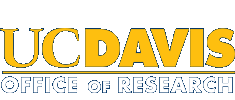Research Communications
This section provides links to resources to help you effectively communicate your message, interact with media and promote your research. It also includes the various communication platforms offered through the university and Office of Research.
Publishing Your Work
 The UC Davis Library provides guidance and resources related to publishing your work that includes open access funding and discounts, copyright best practices and your rights as an author.
The UC Davis Library provides guidance and resources related to publishing your work that includes open access funding and discounts, copyright best practices and your rights as an author.
Communication Training
 Whether you are meeting with a potential scientific collaborator, legislator, industry partner, donor or student, being able to clearly communicate your work in a manner that will instill knowledge and trigger action is an important skill for any researcher to be successful.
Whether you are meeting with a potential scientific collaborator, legislator, industry partner, donor or student, being able to clearly communicate your work in a manner that will instill knowledge and trigger action is an important skill for any researcher to be successful.
Promoting Your Research
 Playing an active role in promoting your research can extend the impact and generate new opportunities. Learn about the various platforms commonly used and the best practices for each.
Playing an active role in promoting your research can extend the impact and generate new opportunities. Learn about the various platforms commonly used and the best practices for each.
Submit News
There are several campus communication channels that can help get the word out about your research. It’s always a good idea to start with your home department and to reach out to your college’s communication staff.
UC Davis Strategic Communications works with researchers from all departments on the UC Davis campus. Strategic Communications issues news releases, maintains the UC Davis home page and associated web pages, manages official campus social media channels and produces Dateline, the faculty/staff email newsletter, among other things. You can find out who covers which discipline here.
The Office of Public Affairs for UC Davis Health provides similar support for researchers on the Health campus in Sacramento. A list of public information officers for the Health campus can be found here.
The Office of Research also promotes research and innovation from across both campuses, with an emphasis on organized research units, special research programs, core labs, and programs affiliated with the Office of Research. Contacts for the marketing and communications unit within the Office of Research can be found here.
Communication Platforms
Stay connected with the latest research and innovation news from UC Davis and submit your related news for inclusion. Our office can assist in routing your news to the appropriate platforms across UC Davis and the UC network.

